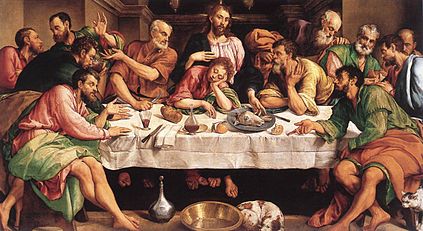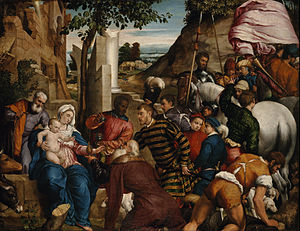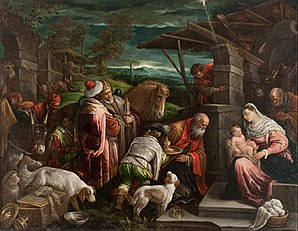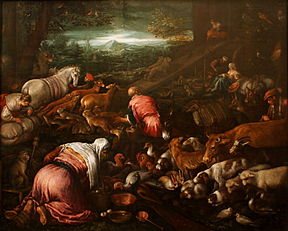Jacopo Bassano
Jacopo da Ponte , called Bassano (* 1510-1515 in Bassano del Grappa , † 13. February 1592 ) was an Italian painter of Mannerism . He lived and worked in the Republic of Venice . Because of his place of birth and death, which is about 65 km from Venice, the name Jacopo Bassano was given to him.
Life and artistic development
With his father Francesco da Ponte d. Ä. (1475–1539), a rather provincial painter in Bassano, the son began his training, which he continued from around 1530 in Venice with Bonifazio Veronese . Bassano took over the strong colors from this, and less so from the Titian , who was so powerful in Venice . His work soon reveals influences from Lorenzo Lotto and Pordenone . After the death of his father, Jacopo finally returned to rural Bassano, where he remained active for the rest of his life.
Accordingly, he often enriches his pictures, which are mainly devoted to religious themes, with realistic motifs of rural life (clothing, animals, tools), so that they have been characterized as forerunners of pastoral and rural genre painting.
In the 1540s, the influence of the Venetian and Tuscan painting of Mannerism became clearer, characterized by dramatic lighting effects, ornamental contour lines and moving physicality. Since the middle of the century he has been painting not only large altars but also small landscape formats for private collectors. In the last years of his life, the dynamism of his colors is increased by the fact that he lets them shine as effective spots of light from darker backgrounds. The landscape spaces widen, the painting style becomes looser and more atmospheric. Some scenes are completely immersed in nocturnal moods from which spots of color and highlights light up; he painted some of these small-format nocturnal pieces on the dark, smooth background of slates. As one of the first artists he liked to use colored chalks in his drawings.
In Bassano's workshop, especially in his late career, four of his sons also took part in the extensive and sometimes even series production of pictures: Francesco , Giovanni Battista (1553–1613), the portrait painter Leandro (1557–1622) and Girolamo (1566–1621) . It is not always certain to whom individual works can be ascribed to . The workshop continued into the 17th century.
The works of the Bassanos can be found scattered in the great museums of the world, but important images have also remained in Bassano del Grappa and its Museo Civico.
- Selection of paintings in chronological order
Last Supper (around 1542), Rome , Galleria Borghese
Adoration of the Magi (around 1552), Budapest, Szépművészeti Múzeum
Crucifixion (around 1575), MNAC , Barcelona
Adoration of the Magi (1575–1580), Barcelona, MNAC
Baptism of Christ in the Jordan (1592) Met, New York
swell
- Michael Bryan: Walter Armstrong & Robert Edmund Graves (Eds.): Dictionary of Painters and Engravers, Biographical and Critical (Volume II LZ) . George Bell and Sons, York St. # 4, Covent Garden, London; Original from Fogg Library, Digitized May 18, 2007 1889, p. 308.
- Jacopo Bassano in the WebMuseum
literature
- Emil Maurer : Mannerism. Figura serpentinata and other ideals of figures. NZZ libro, Zurich 2001 and Wilhelm Fink, Munich 2001 ISBN 3-7705-3523-5 ; as TB ISBN 3-85823-791-4 , passim
- Bastian Eclercy et al. a .: Titian and the Renaissance in Venice , Munich: Prestel, 2019
- P. Zampetti: Bassano , In: Kindler Malereilexikon, Munich: dtv, 1976, pp. 229–232.
- Hans Aurenhammer: Bassano, Jacopo , In: Allgemeines Künstlerlexikon, Vol. 7, 1993, pp. 385-388.
Web links
- Literature by and about Jacopo Bassano in the catalog of the German National Library
- Works by Jacopo Bassano at Zeno.org .
- Jacopo Bassano at artfacts.net
- Biography at Treccani.it Enciclopedia Italiana
- Selection of works at the Musei di Bassano del Grappa (Italian)
Individual evidence
| personal data | |
|---|---|
| SURNAME | Bassano, Jacopo |
| ALTERNATIVE NAMES | Ponte, Jacopo da (real name) |
| BRIEF DESCRIPTION | Italian painter |
| DATE OF BIRTH | 1515 |
| PLACE OF BIRTH | Bassano del Grappa |
| DATE OF DEATH | February 13, 1592 |
| Place of death | Bassano del Grappa |












